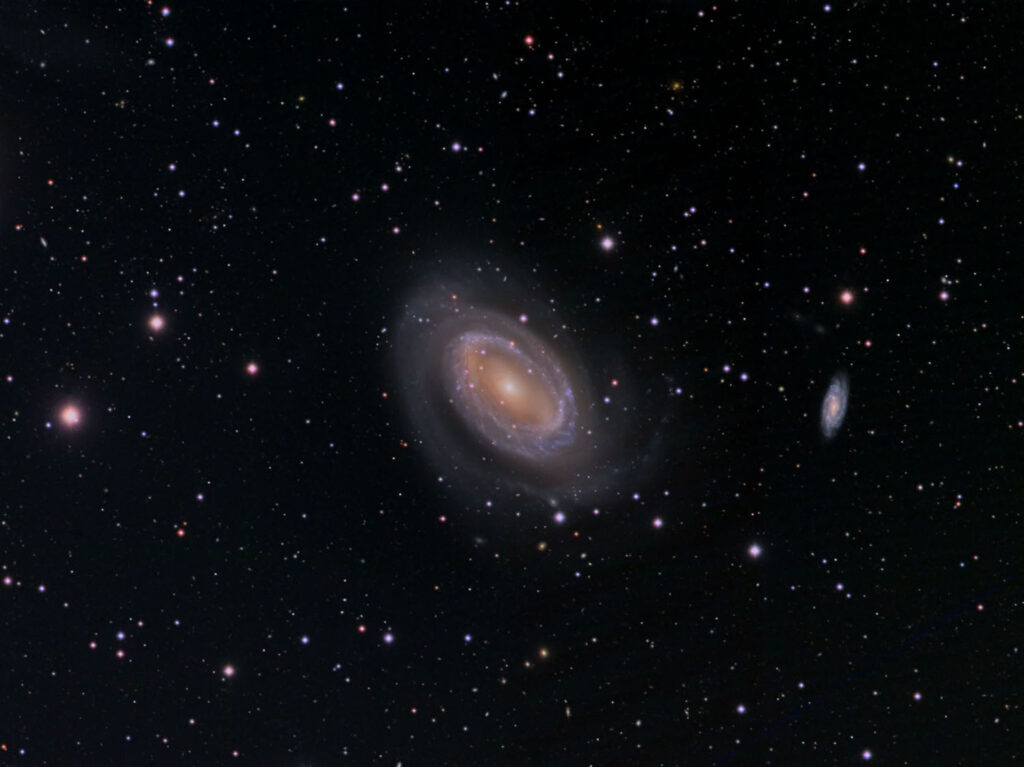NGC 4725
Intermediate Barred-Spiral Galaxy, Coma Berenices
- Description
- Technical
- Links
NGC 4725 is an intermediate barred spiral galaxy with a prominent ring structure,[9] located in the northern constellation of Coma Berenices near the north galactic pole.[10] It was discovered by German-born astronomer William Herschel on April 6, 1785.[11] The galaxy lies at a distance of approximately 40 megalight-years[4] from the Milky Way.
NGC 4725 is the brightest member of the Coma I Group[12] of the Coma-Sculptor Cloud, although it is relatively isolated from the other members of this group.[6] This galaxy is strongly disturbed and is interacting with neighboring spiral galaxy NGC 4747, with its spiral arms showing indications of warping. The pair have an angular separation of 24′, which corresponds to a projected linear separation of 370 kly.[5] A tidal plume extends from NGC 4747 toward NGC 4725.[10]
This is a suspected type 2 Seyfert galaxy with a supermassive black hole at the core.[13] The morphological classification of this galaxy is SAB(r)ab pec,[5] indicating a peculiar, weakly-barred spiral galaxy (SAB) with a complete ring surrounding the bar (r) and somewhat tightly-wound spiral arms (ab). It is actually double-barred, a feature found among about a third of all barred spirals.[14] The galactic plane is inclined by approximately 46° to the line of sight from the Earth.[6]
NGC 4725 is an intermediate barred spiral galaxy with a prominent ring structure, located in the northern constellation of Coma Berenices near the north galactic pole. It was discovered by German-born astronomer William Herschel on April 6, 1785. The galaxy lies at a distance of approximately 40 megalight-years from the Milky Way.
NGC 4725 is the brightest member of the Coma I Group of the Coma-Sculptor Cloud, although it is relatively isolated from the other members of this group. This galaxy is strongly disturbed and is interacting with neighboring spiral galaxy NGC 4747, with its spiral arms showing indications of warping. The pair have an angular separation of 24′, which corresponds to a projected linear separation of 370 kly. A tidal plume extends from NGC 4747 toward NGC 4725.
This is a suspected type 2 Seyfert galaxy with a supermassive black hole at the core. The morphological classification of this galaxy is SAB(r)ab pec, indicating a peculiar, weakly-barred spiral galaxy (SAB) with a complete ring surrounding the bar (r) and somewhat tightly-wound spiral arms (ab). It is actually double-barred, a feature found among about a third of all barred spirals. The galactic plane is inclined by approximately 46° to the line of sight from the Earth.
The ring structure of the galaxy is a region of star formation. It is offset from the galactic center and displays non-circular motion. There is a compact radio source positioned approximately 6.2 kly from the nucleus of NGC 4725. Since there is no optical counterpart at that position, this may be a star forming region that is heavily obscured by dust.
Telescope: Astro Physics 305 Riccardi Honders Astrograph f3.8
Mount: Astro Physics 3600GTO “El Capitan”
Camera: FLI ML50100 / CFW10-7
Guider: Mini Borg 50 / SBIG STi
L: 81×10 mins = 810 mins, R: 24×10 mins = 240 mins, G: 24×10 mins = 240 mins, B: 24×10 mins = 240 mins
Total Imaging Time: 25h 30m
Data Imaged remotely over 8 nights during May 2020.
Data acquisition & Processing by David Churchill.
None

